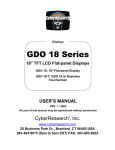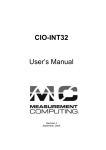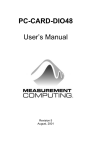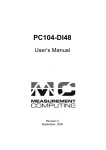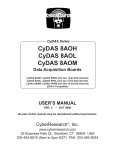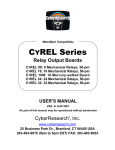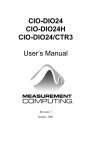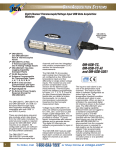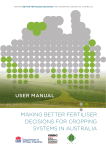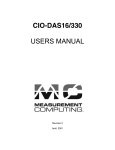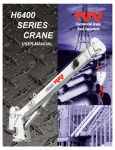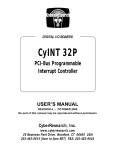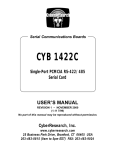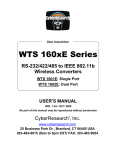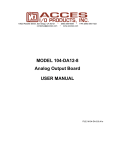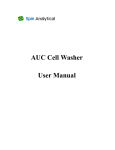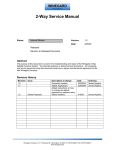Download CYCTM Series - CyberResearch
Transcript
Digital I/O CYCTM Series Counter/Timer Boards CYCTM 05: 5-Ch. C/T Board, 16 DIO, 100ppM, 37-pin CYCTM 10: 10-Ch. C/T Board, 32 DIO, 100ppM, 37-pin CYCTM 05X: High-Accuracy (50ppM) CYCTM 05, 37-pin CYCTM 10X: High-Accuracy (50ppM) CYCTM 10, 37-pin USER’S MANUAL VER. 5.0 • OCT 2000 & No part of this manual may be reproduced without permission. CyberResearch®, Inc. www.cyberresearch.com 25 Business Park Dr., Branford, CT 06405 USA 18 203-483-8815 (9am to 5pm EST) FAX: 203-483-9024 This page is blank. ©Copyright 2000 All Rights Reserved. October 2000 The information in this document is subject to change without prior notice in order to improve reliability, design, and function and does not represent a commitment on the part of CyberResearch, Inc. In no event will CyberResearch, Inc. be liable for direct, indirect, special, incidental, or consequential damages arising out of the use of or inability to use the product or documentation, even if advised of the possibility of such damages. This document contains proprietary information protected by copyright. All rights are reserved. No part of this manual may be reproduced by any mechanical, electronic, or other means in any form without prior written permission of CyberResearch, Inc. TRADEMARKS “CyberResearch,” “CYCTM 05,” and “CYCTM 10” are trademarks of CyberResearch, Inc. Other product names mentioned herein are used for identification purposes only and may be trademarks and/or registered trademarks of their respective companies. • NOTICE • CyberResearch, Inc. does not authorize any CyberResearch product for use in life support systems, medical equipment, and/or medical devices without the written approval of the President of CyberResearch, Inc. Life support devices and systems are devices or systems which are intended for surgical implantation into the body, or to support or sustain life and whose failure to perform can be reasonably expected to result in injury. Other medical equipment includes devices used for monitoring, data acquisition, modification, or notification purposes in relation to life support, life sustaining, or vital statistic recording. CyberResearch products are not designed with the components required, are not subject to the testing required, and are not submitted to the certification required to ensure a level of reliability appropriate for the treatment and diagnosis of humans. i This page is blank. ii TABLE OF CONTENTS INTRODUCTION. . . . . . . . . . . . . . . . . . . . . . . . . . . . . . . . . . . . . . . . . . . . . . . . . . . i 1 SOFTWARE INSTALLATION . . . . . . . . . . . . . . . . . . . . . . . . . . . . . . . . . . . . . . 1 2 HARDWARE INSTALLATION . . . . . . . . . . . . . . . . . . . . . . . . . . . . . . . . . . . . . 2 2.1 BASE ADDRESS . . . . . . . . . . . . . . . . . . . . . . . . . . . . . . . . . . . . . . . . . . . . . . 3 2.2 INTERRUPT LEVEL SELECT . . . . . . . . . . . . . . . . . . . . . . . . . . . . . . . . . . . 4 2.3 WAIT STATE JUMPER . . . . . . . . . . . . . . . . . . . . . . . . . . . . . . . . . . . . . . . . 5 2.4 INSTALLING THE CYCTM IN THE COMPUTER . . . . . . . . . . . . . . . . . 5 3 I/O CONNECTOR & PINOUT . . . . . . . . . . . . . . . . . . . . . . . . . . . . . . . . . . . . . . . 6 3.1 CYCTM 10 SECOND 9513 . . . . . . . . . . . . . . . . . . . . . . . . . . . . . . . . . . . . . 6 4 REGISTER ARCHITECTURE . . . . . . . . . . . . . . . . . . . . . . . . . . . . . . . . . . . . . . . 7 4.1 CONTROL & DATA REGISTERS . . . . . . . . . . . . . . . . . . . . . . . . . . . . . . . . 7 4.2 CYCTM 10 & CYCTM 05 ADDRESSES . . . . . . . . . . . . . . . . . . . . . . . . . . 7 4.3 DIGITAL I/O REGISTERS . . . . . . . . . . . . . . . . . . . . . . . . . . . . . . . . . . . . . . 8 5 SPECIFICATIONS . . . . . . . . . . . . . . . . . . . . . . . . . . . . . . . . . . . . . . . . . . . . . . . . 10 6 ELECTRONICS AND INTERFACING . . . . . . . . . . . . . . . . . . . . . . . . . . . . . . 12 6.1 VOLTAGE DIVIDERS . . . . . . . . . . . . . . . . . . . . . . . . . . . . . . . . . . . . . . . . 12 6.2 LOW PASS FILTERS DE-BOUNCE INPUTS . . . . . . . . . . . . . . . . . . . . . 13 This page is blank. INTRODUCTION The CYCTM 10 is a single board containing two CYCTM 05 boards. From this point forward we will refer to both boards as the CYCTM, and will only use the complete board name in instances where items are specific to one board or the other. The CYCTM family is fully supported by the powerful Universal Library package. Details regarding installation and usage of the Universal Library software can be found in the Universal Library documentation. Please note that InstaCal (shipped with the board) creates a configuration file required for programmers who use the Universal Library programming libraries. i This page is blank. 1 SOFTWARE INSTALLATION The CYCTM boards have a variety of switches and jumpers to set before installing to your computer. By far the simplest way to configure a board is to use the InstaCalTM program provided as part of your software package. InstaCalTM will show you all available options, how to configure the various switches and jumpers (as applicable) to match your application requirements, and will create a configuration file that your application software (and the Universal Library) will refer to so the software you use will automatically know the exact configuration of the board. Please refer to the Extended Software Installation Manual regarding the installation and operation of InstaCalTM. The following hard copy information is provided as a matter of completeness, and will allow you to set the hardware configuration of the board if you do not have immediate access to InstaCalTM and/or your computer. 1 This page is blank. 2 HARDWARE INSTALLATION We highly recommend that you use the InstaCAL procedure to guide you through setting up your board. However, the following sections are provided in case you need to set up your board and you do not have access to the InstaCAL program. The CYCTM have one bank of switches, a base address switch, and one jumper block, which must be set before installing the board in your computer. 2 2.1 BASE ADDRESS Unless there is already a board in your system which uses address 300h (768 Decimal) then you can leave the switches as they are set at the factory. In the example shown here, the CYCTM is set for base address 300h (768 Decimal). Certain address are used by the PC, others are free and may be used by the CYCTM and other expansion boards. We recommend BASE = 300h (768D) be tried first. HEX RANGE 000-00F 020-021 040-043 060-063 060-064 070-071 080-08F 0A0-0A1 0A0-0AF 0C0-0DF 0F0-0FF 1F0-1FF 210-21F 238-23B 23C-23F 270-27F 2B0-2BF FUNCTION 8237 DMA #1 8259 PIC #1 8253 TIMER 8255 PPI (XT) 8742 CONTROLLER (AT) CMOS RAM & NMI MASK (AT) DMA PAGE REGISTERS 8259 PIC #2 NMI MASK (XT) 8237 #2 (AT) 80287 NUMERIC CO-P (AT) HARD DISK (AT) EXPANSION UNIT (XT) BUS MOUSE ALT BUS MOUSE PARALLEL PRINTER EGA HEX RANGE 2C0-2CF 2D0-2DF 2E0-2E7 2E8-2EF 2F8-2FF 300-30F FUNCTION EGA EGA GPIB (AT) SERIAL PORT SERIAL PORT PROTOTYPE CARD 310-31F 320-32F 378-37F 380-38F 3A0-3AF PROTOTYPE CARD HARD DISK (XT) PARALLEL PRINTER SDLC SDLC 3B0-3BB 3C0-3CF 3D0-3DF 3E8-3EF 3F0-3F7 3F8-3FF MDA EGA CGA SERIAL PORT FLOPPY DISK SERIAL PORT The CYCTM BASE switch may be set for address in the range of 000-3F8 (000-3FC for CYCTM 05) so it should not be hard to find a free address area for your CYCTM. Once again, if you are not using IBM prototyping cards, or some other board that occupies these addresses, 300-31F HEX are free to use. Address not specifically listed, such as 390-39F, are usually free. 3 2.2 INTERRUPT LEVEL SELECT There are two rows of jumper blocks on the CYCTM 10 and one on the CYCTM 05, located just above the PC bus interface (gold pins). The factory default setting has no interrupt level set. The jumper is in the 'X' position. Please leave the jumper in the 'X' position for now. Interrupts are hardware initiated software routines and are described in the section on programming. 2 On the CYCTM 10 the lower block, J2, is for the IR input on P1. The upper block, J3, is for the IR input on P2 3 4 5 6 7 X J3 Input at P2 The trigger logic on the CYCTM is quite simple. Pin 1 of the 37 pin connector is an input jumper which maps the interrupt directly onto the PC bus. The signal to the bus is buffered. The buffer is enabled by a TTL low level on Pin 2, interrupt enable. J2 Input at P1 CYCTM INTERRUPT JUMPER BLOCK - IRQ Level. The jumper is in the X position The interrupt level jumper on the which equals no IRQ. CYCTM must also be installed. Move it from the 'X' position to the IRQ number you want the interrupt pulse on. On the CYCTM 10, jumper block J2 is associated with the signals on connector P1. Jumper block J3 is associated with the signals on connector P2. Hardware interrupts (assigned by the PC), may be available. NAME NMI IRQ0 (AT) IRQ1 IRQ2 DESCRIPTION PARITY TIMER KEYBOARD RESERVED (XT) INT 8-15 (AT) IRQ3 COM OR SDLC IRQ4 COM OR SDLC IRQ5 HARD DISK (AT) LPT (AT) IRQ6 FLOPPY DISK IRQ7 LPT IRQ8-15 are AT only. NAME IRQ8 IRQ9 DESCRIPTION REAL TIME CLOCK (AT) RE-DIRECTED TO IRQ2 IRQ10 IRQ11 UNASSIGNED UNASSIGNED IRQ12 IRQ13 IRQ14 UNASSIGNED 80287 NUMERIC CO-P HARD DISK IRQ15 UNASSIGNED 4 2.3 WAIT STATE JUMPER ON The CYCTM boards have a wait state jumper which can enable an on-board wait state generator. A wait state is an extra delay injected into the processor's clock via the bus. This delay slows down the processor so that signals from slow devices (chips) will be valid. OFF J1 WAIT STATE JUMPER BLOCK - For a wait state, place the jumper on the two leftmost pins. No wait state is selected here. The wait state generator on the CYCTM is only active when the CYCTM is being accessed. Your PC will not be slowed down in general by using the wait state. We recommend that the wait state be used in all 16MHz or faster PCs. 2.4 INSTALLING THE CYCTM IN THE COMPUTER Turn the power off. Remove the cover of your computer. Please be careful not to dislodge any of the cables installed in your computer as you slide the cover off. Locate an empty expansion slot in your computer. If you are installing a CYCTM 10, it is best to locate two slots side by side. If you are able to free two slots next to one another, do so. From the rear of the computer, place the CYCTM 10 in the rightmost of the two empty slots. This means that the empty slot is on the component side of the CYCTM. Cabling will be easier if there is an empty slot on the component side of the board. Push the board firmly down into the expansion bus connector. If it is not seated fully it may fail to work and could short circuit the PC bus power onto a PC bus signal. This could damage the motherboard in your PC as well as the CYCTM. The CYCTM connector is a male 37-pin D-type connector. All the signals from the 9513, digital input, digital output and interrupt are accessible. The CYCTM 10 has two of these connectors: P1 and P2; the signals on both are identical. 5 3 I/O CONNECTOR & PINOUT CTR 2 IN 19 CTR 2 GATE 18 CTR 3 IN 17 CTR 3 GATE 16 CTR 4 IN 15 CTR 4 GATE 14 CTR 5 IN 13 CTR 5 GATE 12 GND 11 D OUT 0 10 D OUT 1 9 D OUT 2 8 D OUT 3 7 D OUT 4 6 D OUT 5 5 D OUT 6 4 D OUT 7 3 IR ENABLE 2 IR INPUT 1 37 36 35 34 33 32 31 30 29 28 27 26 25 24 23 22 21 20 CTR 1 GATE CTR 1 IN CTR 1 OUT CTR 2 OUT CTR 3 OUT CTR 4 OUT CTR 5 OUT OSC. OUT D IN 0 D IN 1 D IN 2 D IN 3 D IN 4 D IN 5 D IN 6 D IN 7 D IN STROBE +5V CYCTM CONNECTOR - View from the rear of the PC. 3.1 CYCTM 10 SECOND 9513 The CYCTM 10 has two 9513 chips on it. The second of these, the one accessible via connector P2 at the rear of the board, is wired up identically to the 9513 on P1. Both are Keithley/MetraByte CTM-05 compatible at the connector and the register level. Software written for the CTM-05, including Labtech Notebook, HP VEE and other third party software can operate both 'CTM-05s'. Simply install one CTM-05 at the BASE ADDRESS and install the other at the BASE ADDRESS + 4. On the CYCTM 10, the second 9513 counter timer chip's address is fixed at the board's base address + 4. If the board were configured at 300H (768 Decimal), then the second 9513 would reside at 304h (772 Decimal). No switches need to be set. 6 4 4.1 REGISTER ARCHITECTURE CONTROL & DATA REGISTERS The CYCTM 10 is composed of 2 AM9513 counter timer chips. The CYCTM 05 contains one 9513. Each 9513 contains five counters of 16 bits each. Associated with each counter are an input source, a count register, a load register, a hold register, an output and a gate. The 9513 is extremely flexible and this flexibility can make it a challenge to program the chip directly. Unlike an Intel 8254 which has a single source, single gate and unique I/O address for each counter, the 9513 is fully programmable and any counter may be internally connected to any gate and receive it's counts from a number of sources. In addition, each counter does not have a unique I/O address. The 9513 takes only two address per chip, one of which is a data path to the counter's load and hold registers. There is no 9513 register information in this manual. Those wishing to know more about the AM9513 and its programming should request the manual from our technical support group. As of this writing there is no charge for the manual. However, we suggest that you use the Universal Library, rather than resort to programming the 9513 directly. It is difficult to program and because programming support is available through the Universal Library, we cannot help with other 9513 programming. 4.2 CYCTM 10 & CYCTM 05 ADDRESSES The CYCTM is an I/O mapped expansion board. The CYCTM 10 occupies eight I/O addresses and the CYCTM 5 occupies four addresses. The first address, or BASE ADDRESS, is determined by setting a bank of switches on the board. Most of the functions that this board is capable of performing can be acheived using the Universal Library. Unless you have a good reason for direct register manipulation, we suggest you use the Universal Library. The register descriptions follow the format: 7 6 5 4 A7 A6 A5 A4 3 A3 7 2 A2 1 A1 0 A0 Where the numbers along the top row are the bit positions within the 8-bit byte and the numbers and symbols in the bottom row are the functions associated with that bit. To write to or read from a register in decimal or HEX, the following weights apply: BIT POSITION 0 1 2 3 4 5 6 7 DECIMAL VALUE 1 2 4 8 16 32 64 128 HEX VALUE 1 2 4 8 10 20 40 80 To write control or data to a register, the individual bits must be set to 0 or 1 then combined to form a byte. Data read from registers must be analyzed to determine which bits are on or off. The method of programming required to set/read bits from bytes is beyond the scope of this manual. It will be covered in most Introduction To Programming books, available from a bookstore. In summary form, the registers and their function are listed on the following table. Within each register are eight bits which may constitute a byte of data or eight individual bit functions. ADDRESS BASE +0 BASE +1 BASE +2 BASE +3 BASE +4 BASE +5 BASE +6 BASE +7 4.3 READ FUNCTION Data from 9513 #1 Status of 9513 #1 Digital input port, P1 No read back of output port CYCTM 10 ONLY Data from 9513 #2 Status of 9513 #2 Digital input port, P2 No read back of output port WRITE FUNCTION Data for 9513 #1 Commands to 9513 #1 Digital output port Data for 9513 #2 Cammands to 9513 #2 Digital output port, P2 DIGITAL I/O REGISTERS The digital input port at BASE + 2 is a 74LS373 input buffer with a strobe line. When STROBE is high, the current status of the inputs to the 74LS373 may be read. When STROBE goes low, the 74LS373 inputs are latched. 8 The digital output port at BASE + 3 is a 74LS273 output buffer. Each write to BASE + 3 places a byte of data on the output port. 9 5 SPECIFICATIONS Typical for 25°C unless otherwise specified. POWER CONSUMPTION +5V CYCTM 10 CYCTM 05 300mA typical, 500mA max 190mA typical, 320mA max COUNTER SECTION Counter type Configuration CYCTM 10 CYCTM 05 9513 Two 9513 devices. 5 counters per 9513, 16 bits each One 9513 device. 5 counters, 16 bits each Clock input frequency X2 Clock input source High pulse width (clock input) Cycle time (clock input) Gate pulse duration Input low voltage Input high voltage Output low voltage Output high voltage Crystal oscillator clock source Frequency accuracy CYCTM 05/10 CYCTM 05X/10X 7Mhz max 1MHz (10MHz Xtal divided by 10) 70ns min 145ns min 145ns min -0.5V min, 0.8V max 2.2V min, 5V max 0.4V max @ 3.2mA 2.4V min @ -200µA 10MHz 100pp m 50ppm 10 DIGITAL I/O Digital Type Output: Input: Configuration Number of channels Output High Output Low Input High Input Low Interrupts Interrupt enable Interrupt sources ENVIRONMENTAL Operating temperature range Storage temperature range Humidity 74LS273 74LS373 2 banks of 8: 1 bank input, 1 bank output, input may be latched via external strobe input (latched on TTL low level) 8 input, 8 output 2.7 volts min @ -0.4mA 0.5 volts max @ 8 mA 2.0 volts min, 7 volts absolute max 0.8 volts max, -0.5 volts absolute min 2 - 7, jumper selectable External, enabled with TTL low level External 0 to 50°C -20 to 70°C 0 to 90% non-condensing 11 6 6.1 ELECTRONICS AND INTERFACING VOLTAGE DIVIDERS An alternative method of measuring a signal which varies over a range greater than the input range of a digital input, is to use a voltage divider. When correctly designed, it can drop the voltage of the input signal to a safe level the digital input can accept. Ohm's law states: Voltage = Current x Resistance Kirkoff's law states: The sum of the voltage drops around a circuit will be equal to the voltage drop for the entire circuit. In a voltage divider, the voltage across one resistor in a series circuit is proportional to the total resistance divided by the one resistor (see formula below). The object in a voltage divider is to choose two resistors having the proportions of the maximum voltage of the input signal to the maximum allowed input voltage. The formula for attenuation is: Attenuation = R1 + R2 R2 2 = 10K + 10K 10K For example, if the signal varies between 0 and 20 volts and you wish to measure that with an analog input with a full scale range of 0 to 10 volts, the attenuation (A) is 2:1 or just 2. R1 = (A-1) x R2 For a given attenuation, pick a resistor and call it R2, the use this formula to calculate R1. Digital inputs often require the use of voltage dividers. For example, if you wish to measure a digital signal that is at 0 volts when off and 24 volts when on, you cannot connect that directly to a digital input. The voltage must be dropped to 5 volts max when on. The attenuation is 24:5 or 4.8. Using the equation above, if R2 is 1K, R1 = (4.8−1) x 1000 = 3.8K. Remember that a TTL input is 'on' when the input voltage is greater than 2.5 volts. 12 Vin SIGNAL HIGH = R1 + R2 R2 Vout R1 V1 A/D BOARD SIGNAL VOLTS Vin HIGH INPUT R2 V2 Vout A/D BOARD LOW INPUT SIGNAL LOW SIMPLE VOLTAGE DIVIDER NOTE The resistors, R1 and R2, are going to dissipate power in the divider circuit according to the equation W = I2 x R; (Current (I) = Voltage/Resistance). The higher the value of the resistance (R1 + R2), the less power dissipated by the divider circuit. Here is a simple rule: For attenuation of <5:1, no resistor should be less than 10K. For attenuation of > 5:1, no resistor should be less than 1K. The STA-01 has the circuitry on board to create custom voltage dividers. It is a is a 16" by 4" screw terminal board with two 37-pin D-type connectors and 56 screw terminals (12 - 22 AWG). Designed for table top, wall, or rack mounting, the board provides prototype, divider circuit, filter circuit and pull-up resistor positions which you may complete with components for your application. 6.2 LOW PASS FILTERS DE-BOUNCE INPUTS A low pass filter is placed on the signal wires between a signal and an A/D board. It prevents frequencies greater than the cut-off frequency from entering the A/D board's digital inputs. 13 The cut-off frequency is that frequency above which no variation of voltage with respect to time may enter the circuit. For example, if a low-pass filter had a cut-off frequency of 30 Hz, interference associated with line voltage (60 Hz) would be mostly filtered out but a signal of 25 Hz would pass with less attenuation. Also, in a digital circuit, a low-pass filter is often used to remove contact bounce noise signals from a switch or a relay contacts. Also, in a digital circuit, a low pass filter might be used to “de-bounce” (filter) an input from a switch or external relay. (Unless switch/relay contacts are mercury-whetted, they tend to bounce briefly on closure, generating a pulsating noise signal. This can easily lead to erroneous counts unless filtered out.) A simple low-pass filter can be constructed from one resistor (R) and one capacitor (C). The cut-off frequency is determined according to the formula: Fc = R= 1 2πRC Where π= 3.14... R = ohms C = farads Fc = cut-off frequency in cycles/second 1 2π C Fc 14 Notes EC Declaration of Conformity We, the manufacturer, declare under sole responsibility that the product: CYCTM 05 CYCTM 10 Part Number 5 channel counter/timer board 10 channel counter/timer board Description to which this declaration relates, meets the essential requirements, is in conformity with, and CE marking has been applied according to the relevant EC Directives listed below using the relevant section of the following EC standards and other normative documents: EU EMC Directive 89/336/EEC: Essential requirements relating to electromagnetic compatibility. EU 55022 Class B: Limits and methods of measurements of radio interference characteristics of information technology equipment. EN 50082-1: EC generic immunity requirements. IEC 801-2: Electrostatic discharge requirements for industrial process measurement and control equipment. IEC 801-3: Radiated electromagnetic field requirements for industrial process measurements and control equipment. IEC 801-4: Electrically fast transients for industrial process measurement and control equipment. 15 Product Service Diagnosis and Debug CyberResearch, Inc. maintains technical support lines staffed by experienced Applications Engineers and Technicians. There is no charge to call and we will return your call promptly if it is received while our lines are busy. Most problems encountered with data acquisition products can be solved over the phone. Signal connections and programming are the two most common sources of difficulty. CyberResearch support personnel can help you solve these problems, especially if you are prepared for the call. To ensure your call’s overall success and expediency: 1) Have the phone close to the PC so you can conveniently and quickly take action that the Applications Engineer might suggest. 2) Be prepared to open your PC, remove boards, report back-switch or jumper settings, and possibly change settings before reinstalling the modules. 3) Have a volt meter handy to take measurements of the signals you are trying to measure as well as the signals on the board, module, or power supply. 4) Isolate problem areas that are not working as you expected. 5) Have the source code to the program you are having trouble with available so that preceding and prerequisite modes can be referenced and discussed. 6) Have the manual at hand. Also have the product’s utility disks and any other relevant disks nearby so programs and version numbers can be checked. Preparation will facilitate the diagnosis procedure, save you time, and avoid repeated calls. Here are a few preliminary actions you can take before you call which may solve some of the more common problems: 1) Check the PC-bus power and any power supply signals. 2) Check the voltage level of the signal between SIGNAL HIGH and SIGNAL LOW, or SIGNAL+ and SIGNAL– . It CANNOT exceed the full scale range of the board. 3) Check the other boards in your PC or modules on the network for address and interrupt conflicts. 4) Refer to the example programs as a baseline for comparing code. 16 Warranty Notice CyberResearch, Inc. warrants that this equipment as furnished will be free from defects in material and workmanship for a period of one year from the confirmed date of purchase by the original buyer and that upon written notice of any such defect, CyberResearch, Inc. will, at its option, repair or replace the defective item under the terms of this warranty, subject to the provisions and specific exclusions listed herein. This warranty shall not apply to equipment that has been previously repaired or altered outside our plant in any way which may, in the judgment of the manufacturer, affect its reliability. Nor will it apply if the equipment has been used in a manner exceeding or inconsistent with its specifications or if the serial number has been removed. CyberResearch, Inc. does not assume any liability for consequential damages as a result from our products uses, and in any event our liability shall not exceed the original selling price of the equipment. The equipment warranty shall constitute the sole and exclusive remedy of any Buyer of Seller equipment and the sole and exclusive liability of the Seller, its successors or assigns, in connection with equipment purchased and in lieu of all other warranties expressed implied or statutory, including, but not limited to, any implied warranty of merchant ability or fitness and all other obligations or liabilities of seller, its successors or assigns. The equipment must be returned postage prepaid. Package it securely and insure it. You will be charged for parts and labor if the warranty period has expired. Returns and RMAs If a CyberResearch product has been diagnosed as being non-functional, is visibly damaged, or must be returned for any other reason, please call for an assigned RMA number. The RMA number is a key piece of information that lets us track and process returned merchandise with the fastest possible turnaround time. PLEASE CALL FOR AN RMA NUMBER! Packages returned without an RMA number will be refused! In most cases, a returned package will be refused at the receiving dock if its contents are not known. The RMA number allows us to reference the history of returned products and determine if they are meeting your application’s requirements. When you call customer service for your RMA number, you will be asked to provide information about the product you are returning, your address, and a contact person at your organization. 17 For your notes.




























